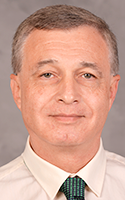By Sergey Kravchick, M.D.
 In the U.S. between 175 000 and 354 000 men undergo a vasectomy each year — about 6 percent of these patients request a reversal procedure.
In the U.S. between 175 000 and 354 000 men undergo a vasectomy each year — about 6 percent of these patients request a reversal procedure.
There are two options to achieve fertility in these patients: vasal repair or testicular sperm extraction (TESE) with intracytoplasmic sperm injection (ICSI).
Vasal repair includes two different techniques: vasovasostomy (VV — when the re-anastomosis between two ends of the vas is performed) and vasoepididymostomy (VE— when the anastomosis between vas and a part of the epididymis is performed).
Pre-operative assessment and predictors of successful operation.
The physical examination includes the size of the testicles, a palpable vasal defect, the presence of a sperm granuloma and the length of the testicular vasal segment. Formal vasography is unnecessary. Laboratory investigations should be considered for patients with small testes, a history of abnormal/borderline semen analysis before the vasectomy, or impaired sexual function.
Patients’ age (more than 40 years), time from the vasectomy (about 10 years), decreased the pre-operative level of LH (luteinizing hormone) and increased level of FSH (follicle-stimulating hormone) — all can be considered as a negative predictor of success. As the VE is a more technically challenging and has a lower success rate than the VV, the following model for VE prediction may be used: (age X 0.31) + (obstructive interval X 0.94). If the prediction score is greater than 20, then the chance for VE is high. If you are in one of these categories, consider TESE with ICSI.
Surgery
Although a VV or VE may be performed by using local, regional or general anesthesia, general anesthesia is chosen in most cases. Generally, bilateral incisions are made 1 cm lateral to the base of the penis. An extension of this incision can be undertaken in cases of VE. The mean operative time for VV is two-three hours, while for VE it can be three-four hours (especially for bilateral VE). To assess the patency of the abdominal vasal end, the surgeon intubates the abdominal end, and a one mL saline is injected gently through a 24-gauge angiocatheter. The vasal fluid from the testicular end is collected on a glass slide for macroscopic examination includes fluid opacity and viscosity and the microscopic examination. If there is no sperm, then VE can be considered.
Postoperative period and outcomes
Patients should use a scrotal supporter for six weeks and to avoid heavy physical activity for three or four weeks, as well as to avoid sexual activity for three or four weeks after surgery. Semen analyses can be done at one, two (first analysis after VE), four and six months postoperatively. The mean patency rate for VV and VE is 87 percent (range: 80-98 percent) and 64 percent (35-72 percent), respectively. The mean pregnancy rate for VV and VE is 72 percent (range: 68-92 percent) and 48 percent (range: 33-61 percent), respectively.
Upstate Urology offers these treatment modalities to patients who consider vasectomy reversal.
Physician Sergey Kravchick specializes in general urology, endourology, male health: chronic prostatitis/chronic pelvic pain syndrome and testicular pain and practices at Upstate Urology at UHS and Wilson Hospital in Binghamton.
